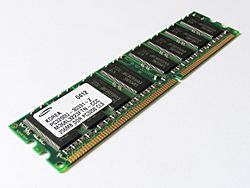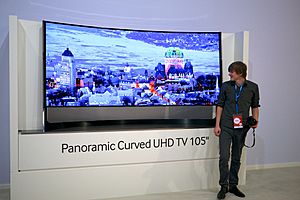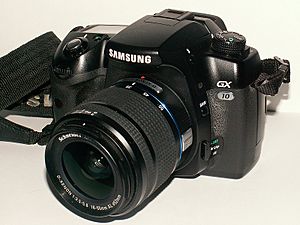Samsung Electronics facts for kids
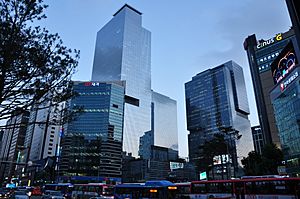
The Samsung headquarters in Seoul, South Korea
|
|
|
Native name
|
삼성전자 주식회사
|
|---|---|
| Hanja |
三星電子株式會社
|
| Revised Romanization | Samseong Jeonja Jusikhoesa |
|
Formerly
|
Samsung Electric Industries (1969–1988) |
| Public | |
| Traded as |
|
| ISIN | KR7005930003 |
| Industry |
|
| Founded | 13 January 1969 in Suwon, South Korea |
| Headquarters | Samsung Digital City, Samsungno 129, Maetan-dong,
Yeongtong District, Suwon
,
South Korea
|
|
Area served
|
Worldwide |
|
Key people
|
|
| Products | See products listing |
| Revenue | |
|
Operating income
|
|
| Total assets | |
| Total equity | |
| Owners |
|
|
Number of employees
|
270,372 (2023) |
| Parent | Samsung |
| Subsidiaries |
|
| Footnotes / references Financials as of 31 December 2024[update] References: |
|
Samsung Electronics Co., Ltd. is a huge company from South Korea. It makes many different home appliances and electronic gadgets. The company started on January 13, 1969, and its main office is in Suwon, South Korea.
Samsung Electronics is a very important part of the larger Samsung group. In 2012, it made 70% of the group's total money. Many people from other countries own parts of Samsung Electronics.
As of 2019, Samsung Electronics was the world's second-largest technology company by how much money it made. It was also the 12th largest company in the world by its total value. Since 2012, it has been the biggest maker of smartphones in the world.
Samsung is famous for its Samsung Galaxy phones. These include the top-tier Galaxy S series, the popular mid-range Galaxy A series, and the special Galaxy Fold and Galaxy Flip series. Samsung has also been the biggest TV maker since 2006. The company also makes washing machines, refrigerators, computer monitors, and soundbars.
Samsung Electronics also makes important electronic components. These include batteries, semiconductors (tiny computer chips), image sensors, and screens. They supply these parts to other big companies like Apple, Sony, and HTC. From 2017 to 2018, Samsung was the world's largest semiconductor company. Samsung Electronics has factories and sales offices in 76 countries. It employs over 260,000 people.
Contents
The Story of Samsung Electronics
How Samsung Electronics Started (1969–1987)
Samsung Electric Industries began on January 13, 1969, in Suwon, South Korea. It was part of the larger Samsung Group. At first, Samsung Group was known for trading things like fertilizers. Even though they didn't have much technology, Samsung Group grew in manufacturing. They worked with Japanese companies to learn more. This helped them improve their skills.
In December 1969, Samsung Electric teamed up with Sanyo and Sumitomo Corporation. This new company was called Samsung-Sanyo Electric. It was the very first version of today's Samsung Electronics. Their first products were TVs, calculators, refrigerators, air conditioners, and washing machines. By 1981, Samsung Electric had made over 10 million black-and-white TVs.
In 1974, Samsung Group started making semiconductors. They bought a company called Korea Semiconductor. Later, in 1983, Samsung decided to become a major maker of dynamic random-access memory (DRAM) chips. Just one year later, they successfully made a 64 kb DRAM chip. This greatly reduced the technology gap between Samsung and older electronics companies. In 1988, Samsung Electric Industries and Samsung Semiconductor & Communications joined together to form Samsung Electronics.
Challenges in the 1990s (1988–1995)
In 1988, Samsung Electronics launched its first mobile phone in South Korea. But sales were not good at first. In the early 1990s, Motorola sold most of the mobile phones in South Korea. Samsung's phones had some quality issues. People at the company even thought about stopping making phones.
Becoming a Leader in Parts and Design (1995–2008)
Samsung's chairman, Lee Kun-Hee, decided the company needed a new plan. Samsung stopped making many products that didn't sell well. Instead, they focused on designing and making parts for other companies. They also invested in new technologies. Samsung wanted to become a top global brand in design. They worked hard to improve their product designs. By the late 1990s, Samsung was winning awards for its designs.
Samsung also sponsored big sports events, like the 1998 Winter Olympics. This helped them become more well-known around the world. Samsung made many important breakthroughs in memory chips. They created the world's first 64 MB DRAM in 1992. They also made the first 8 GB NAND flash memory chip in 2004. Samsung even made a deal to supply memory chips to Apple in 2005.
Growth and New Innovations (2008–Present)
From 2000 to 2003, Samsung continued to grow. In 2005, Samsung became more popular than its rival, Sony. By 2007, Samsung was the world's second-largest smartphone maker. In 2009, Samsung made $117 billion in sales. This made it the world's largest technology company by sales.
Samsung faced some legal issues in 2009 and 2010. They were fined for being involved in discussions about how memory chip prices were set. However, Samsung helped the EU investigate other companies in a similar case about LCD screen prices.
In 2010, Samsung's chairman, Lee Kun-hee, said the company needed to keep innovating. He said that many of their main products could become old-fashioned in ten years. Samsung set big goals to keep growing.
In 2011, Samsung sold its hard disk drive (HDD) business to Seagate Technology. In 2012, Kwon Oh-hyun became the CEO of Samsung Electronics. He stepped down in 2017, saying the company was facing a "crisis." After that, Samsung had three co-CEOs until 2021. Then, Kyung Kye-Hyun and Han Jong-hee became the new CEOs.
In 2014, Samsung launched the Samsung Galaxy S4 smartphone. They also successfully tested advanced 5G technology. Samsung kept growing in technology markets. In 2015, they bought SmartThings, a company that makes smart home devices.
In 2016, Samsung had a big problem with its Galaxy Note 7 phones. Some of them overheated and caught fire because of battery issues. This led to a worldwide recall of the product. But Samsung recovered by launching successful phones like the Galaxy S8 and Galaxy Note 8 in 2017. In 2016, Samsung also bought Harman International Industries for $8 billion. This was a big step into making technology for cars.
In 2017, Samsung made record profits, especially from its semiconductor business. By 2018, Samsung was one of the top makers of semiconductors. In 2021, Samsung announced plans to build a new chip factory in Taylor, Texas. This helps them make more chips during a worldwide shortage.
On May 20, 2022, US President Joe Biden and South Korean President Yoon Suk-yeol visited Samsung's chip factory in Pyeongtaek, South Korea. They talked about how important the chip industry is and how the two countries can work together on technology.
At CES 2024, Samsung showed off Ballie, a home robot powered by AI. It helps with daily tasks and connects to smart home devices. Samsung is also working on being more environmentally friendly. In 2023, they partnered with British Gas to help people save energy using the Samsung SmartThings app.
In 2025, Samsung Electronics became the largest owner of Rainbow Robotics, a South Korean company. On March 25, 2025, Samsung Electronics co-CEO Han Jong-hee passed away. Jun Young-hyun became the company's sole leader. On June 2, 2025, Samsung Electronics discussed investing in Perplexity AI Inc.. They also talked about putting Perplexity's search technology on Samsung devices and in the Samsung web browser.
How Samsung is Managed
Samsung Electronics is owned by many different people and groups. As of January 2024, about 44% of its shares are owned by the public. About 38% are owned by large organizations.
Global Recognition
In April 2024, Samsung Electronics was ranked 21st among the top 100 companies in the world by market value. In January 2025, Samsung Electronics was ranked first in the 'Best Global Brands' list by YouGov, a company that studies markets.
Company Logos Over Time
What Samsung Electronics Does
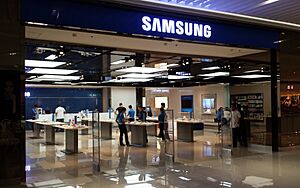
Samsung Electronics focuses on four main areas:
- Digital Media: This includes laptops, TVs, computer monitors, DVD players, MP3 players, digital camcorders, and home appliances like refrigerators and washing machines.
- Semiconductors: This area makes tiny computer chips like memory chips (SDRAM, NAND flash), smart cards, and mobile processors.
- Telecommunication Networks: This includes mobile phones, PDA phones, and satellite receivers.
- LCD Digital Appliances: This part makes TFT-LCD and organic light-emitting diode (OLED) screens for laptops, monitors, and TVs.
Samsung Print was a separate part of the company that made printers. But in 2018, Samsung sold its printing business to HP.
Samsung Products
Samsung Electronics makes many products, including LCD and LED screens, mobile phones, memory chips, NAND flash, solid-state drives, televisions, and laptops. They used to make hard drives and printers.
Samsung always invests in new ideas. In 2021, Samsung was ranked 2nd in the world for the number of patent applications they published. This shows how much they focus on creating new technologies.
LCD and OLED Screens
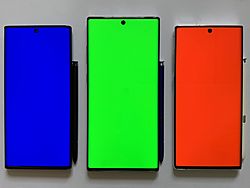
By 2004, Samsung was the world's largest maker of OLED screens. As of 2018, they made 98% of all AMOLED screens globally. In 2011, Samsung announced its Super AMOLED Plus displays. These screens are better than older ones because they are thinner, brighter, and use less energy.
In 2007, Samsung made a very thin 40-inch LCD TV panel. In 2008, they made the world's first 7.9-mm panel. In 2009, Samsung made a 40-inch LED TV panel that was only 3.9 millimeters thick. This "Needle Slim" panel was as thin as two coins stacked together.
In October 2013, Samsung released the Samsung Galaxy Round smartphone. It had the "world's first commercialized full HD Super AMOLED flexible display." This screen could be tilted to check information like time and battery life. In 2020, Samsung Display announced it would stop making LCD screens.
Mobile Phones and Smartphones
Samsung's mobile phone business started with a car phone in 1984. Their first handheld mobile phone, the SH-100, came out in 1988. By 1995, Samsung was the biggest mobile phone company in South Korea. In 1998, Samsung became the largest seller in major CDMA markets.
In 1999, Samsung released the first "MP3 phone," the SCH-M210. In the early 2000s, Samsung made flip phones popular. The SGH-T100 was the first "true color" mobile phone. It sold over 10 million units. In 2007, Samsung became the world's second-largest mobile phone maker.
Today, Samsung's main smartphone line is the Galaxy S series. Many people see it as a direct competitor to the iPhone. The first Galaxy S phone launched in 2010. It sold over one million units in the United States in just 45 days.
Samsung used to use many different operating systems for its phones. But by 2013, they mainly used Android and Windows Phone. In 2010, Samsung sold 280 million mobile phones. In 2011, Samsung became the world's largest smartphone maker. They sold 95 million phones in the first three months of 2012.
In 2019, Samsung stopped making mobile phones in China because people there weren't buying them as much. Samsung now has over 200,000 employees in Vietnam who make smartphones. They also make many phones in India.
In May 2022, Samsung Electronics added Samsung Knox Guard to its mobile security platform. This helps companies make phones unusable if they are stolen. This can help prevent theft and protect data.
Semiconductors (Computer Chips)
Samsung Electronics has been the world's largest maker of memory chips since 1993. It was also the largest semiconductor company from 2017 to 2018. Samsung's Semiconductor division makes various semiconductor devices, including memory chips.
Since the early 1990s, Samsung Electronics has created many new memory technologies. They introduced SDRAM in 1992. Later, they made DDR SDRAM and GDDR in 1998. In 2009, Samsung started making 30 nm-class NAND flash memory. In 2010, they made 30 nm-class DRAM and 20 nm-class NAND flash. These were world firsts.
Samsung also makes chips for other companies. They started investing in this "foundry" business in 2006. Samsung has been a leader in making semiconductor devices. They began mass-producing 20 nm chips in 2010. They followed this with 10 nm chips in 2013 and 7 nm chips in 2018. They also started making the first 5 nm chips in late 2018.
In 2010, market researchers predicted that Samsung would become the world's biggest semiconductor chip supplier by 2014. Samsung did surpass Intel to become the largest semiconductor company in the world in 2017. By mid-2020, Samsung planned to start making 5 nm chips using advanced technology.
On November 30, 2021, Samsung announced they would make new car chips for Volkswagen. These chips help entertainment systems provide 5G internet. Samsung's factory in Xi'an, China, makes about 40% of its NAND flash memory chips.
Solid-State Drives (SSDs)
In 2016, Samsung released a 15.36 TB SSD. This was the first time an SSD had more storage than the largest hard disk drive (HDD). In 2018, Samsung introduced a 30.72 TB SSD. They also made an M.2 NVMe SSD with very fast read and write speeds. In 2019, Samsung introduced SSDs that could move data from damaged chips to working ones. This allows the SSD to keep working even if some parts are broken.
Samsung's SSDs for regular users include the 980 PRO, 970 PRO, and 860 EVO. The 9-series SSDs use a faster NVM Express connection. Other models use a Serial ATA connection. Samsung also makes portable SSDs that connect with USB-C. These drives are very fast and come in different storage sizes. Like many other SSD makers, Samsung uses its own NAND flash memory in its SSDs.
Televisions
In 2009, Samsung sold about 31 million flat-panel TVs. This made them the world's largest TV market share for the fourth year in a row. Samsung launched its first full HD 3D LED TV in March 2010. They sold over one million 3D TVs within six months. Samsung also made a 3D Home Theater system. This meant Samsung was the first company to offer a full range of 3D products.
In 2007, Samsung introduced "Internet TV." This allowed people to get information from the internet while watching TV. Samsung later developed "Smart LED TV," now called "Samsung Smart TV." These TVs can download smart television apps. In 2010, Samsung started selling 3D TVs. They also updated their Internet@TV service. This allowed users to download apps from the Samsung Apps Store. Samsung Apps offers paid services in some countries. Samsung's smart TVs include apps like ITV Player and games like Angry Birds. Since 2015, Samsung's free streaming service Samsung TV Plus has been on its smart TVs.
Monitors
Samsung started making display monitors in the 1980s. They made cathode ray tube (CRT) monitors for computers. By 1989, Samsung was the world's largest monitor maker. They sold over 8 million monitors that year.
In the 1990s and 2000s, Samsung began making LCD monitors using TFT technology. They focused on affordable monitors. They also worked with brands like NEC and Sony through joint ventures. As Samsung grew, they took over these joint ventures. This formed the current Samsung OLED and S-LCD Corporation.
Tizen Operating System
Since 2015, Samsung smart TVs and monitors use an operating system called Tizen OS. This system is based on Linux. Because Samsung sells so many smart TVs, about 20% of smart TVs sold worldwide in 2018 run Tizen. In 2019, Samsung announced that its 2018 and 2019 smart TVs would get the Apple TV app and AirPlay 2 support.
Odyssey Gaming Monitors
Samsung's Odyssey gaming monitors are made for serious gamers. As of 2022, the Odyssey series has four main types. They offer different screen resolutions, refresh rates, and shapes. At the CES 2022 show, Samsung showed the Odyssey Neo G8. It was the world's first 4K monitor with a 240 Hz refresh rate. It has a 32-inch curved screen with mini LED technology.
Audio Products
In 2017, Samsung bought Harman International. Harman makes high-quality audio products under many brand names. These include AKG, Harman Kardon, JBL, and Bang & Olufsen. In May 2025, Harman agreed to buy other audio brands like Bowers & Wilkins and Marantz.
Cameras
Samsung has made several digital cameras and camcorders. These include the WB550 camera and the HMX-H106 full HD camcorder. In 2014, Samsung was the second-largest company in the mirrorless camera market. In 2010, the company launched the NX10, a new type of camera with interchangeable lenses.
Other Products
Samsung entered the MP3 player market in 1999 with its Yepp line. By 2006, they had a good share of the market in Korea, Russia, and parts of Europe. In 2009, Samsung launched the world's smallest DivX MP3 player, the R1.
In 2014, Samsung announced it was stopping selling laptops in Europe.
In 2015, Samsung suggested a plan for 4600 satellites orbiting Earth. These satellites could bring 200 gigabytes of internet data per month to 5 billion people worldwide. This plan has not yet been fully developed.
On July 13, 2017, Samsung Electronics showed an LED screen for digital cinema in Seoul. This screen was developed with GDC Technology Limited.
Samsung Stores
Samsung has Samsung Experience Store locations around the world. These stores mainly sell Samsung Galaxy devices. They also feature products from other Samsung-owned brands. In South Korea, Samsung has many service stores. These stores show Samsung products and offer repair services. They also have stores for installing large home appliances and for selling memory products.
Management and Leadership
In December 2010, Samsung changed its management system. It went from having one CEO to a two-person team. In June 2012, Kwon Oh-Hyun became the CEO. In 2012, J. K. Shin, the director of mobile products, became president and CEO of Samsung Electronics for Mobile Consumer Products.
The company added a new digital imaging business division in 2010. It now has eight divisions. These include display, IT solutions, consumer electronics, wireless, networking, semiconductor, and LCD divisions. In 2010, consumer electronics and air conditioners were combined.
As of 2023, the company's leaders are:
- Executive Chairman: Lee Jae-yong
- Vice Chairman and co-CEO of Samsung Electronics' device experience division: Han Jong Hee
- Co-CEO of the device solutions division: Kyung Kye-hyun
- Vice Chairman and head of the Future Business Planning division: Jun Young-hyun
Who Owns Samsung Electronics
About 44% of Samsung Electronics' shares are owned by the general public. About 38% are owned by large organizations. And about 4% are owned by people who work for the company. The biggest owners in early 2024 included Samsung Life Insurance, National Pension Service, and BlackRock.
Samsung has a large share of the global market for many of its products:
- Active-matrix OLEDs: 98% (Q2 2010)
- DRAM: 49.6% (Q2 2013)
- NAND flash: 42.6% (Q2 2011)
- Mobile phones: 34% (Q3 2013)
- Solid-state drives (SSD): 46.8% (Q4 2015)
- Televisions: 24% (Q2 2010)
Major Customers
Samsung sells its products to many big companies. Here are some of its largest customers in early 2010:
- Sony: Buys DRAM, NAND flash, LCD panels, and more.
- Apple Inc.: Buys mobile processors, AMOLED displays, DRAM, NAND flash, and more.
- Dell: Buys DRAM, flat-panels, and batteries.
- Hewlett-Packard: Buys DRAM, flat-panels, and batteries.
- Verizon Communications: Buys mobile phones.
- AT&T Inc.: Buys mobile phones.
Working with Apple Inc.
Even though they have had legal disagreements, Samsung and Apple have a unique relationship. Samsung is a major supplier for Apple. Samsung provided memory for early iPods in 2005. Apple is also a very important customer for Samsung. In 2012, Apple's purchases were worth about $8 billion to Samsung.
In April 2011, Apple Inc. sued Samsung. Apple said that Samsung's Galaxy phones copied the design of the iPhone and iPad. Samsung then sued Apple back. In August 2011, a court in Germany temporarily stopped the sale of the Samsung Galaxy Tab 10.1 in most of Europe. However, this ban was later lifted in the European Union, except for Germany.
On August 31, 2012, a court in Tokyo said that Samsung's devices did not break an Apple patent. On October 18, 2012, a UK court also ruled that Samsung did not copy Apple's designs. Apple had to put an apology to Samsung on its official UK website.
Working with Best Buy Co, Inc.
Best Buy and Samsung worked together to create the Samsung Experience Shop. These shops let customers try out Samsung products. They also offer training for mobile products that customers already own. By summer 2013, over 1,400 Best Buy stores had Samsung Experience Shops. These shops are usually near the entrance of Best Buy stores. Their goal is to make Samsung products, like the Galaxy phones, easier for customers to access.
The first Samsung Experience Shops opened in the United States in May 2013. In May 2014, Best Buy planned to add 500 new Samsung Entertainment Experience Shops. These new shops focus on Samsung's home theater products. Samsung-trained Best Buy employees run these new centers.
Product Design
In the early 1990s, Samsung started to see how important product design was. In 1996, Chairman Lee called it the "Year of Design Revolution." Samsung started a big design program to make design a key part of its success. The company's main design center in Seoul has over 900 full-time designers. In 1971, there were only a few designers in the whole company. By 2015, that number grew to 1,600. Samsung also has design centers in Tokyo, San Francisco, and London.
The company updates its designs every two years. First, they study design trends around the world. Then, they plan new designs. Since 2006, Samsung has won 210 awards from international design groups. They have received iF (International Forum) and IDEA design awards. In the 2009 IDEA awards, Samsung won the most awards, with eight categories.
In the 2010 iF Material Awards, Samsung won the Gold Award for five products. These awards are for design materials and technologies. Samsung won for its external hard disk, full-touch screen phone, refrigerator, digital camera, and laser printer toner.



